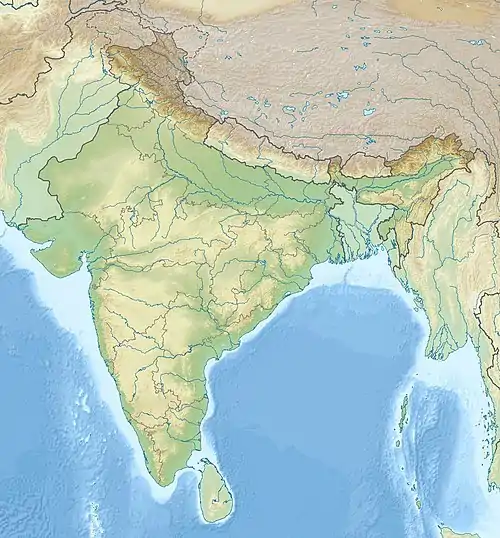
| Part of a series on |
| Vaishnavism |
|---|
 |
Tikla, or Tikula, is an archeological site and ancient rock shelter in Madhya Pradesh, India, known for its petroglyphs.[1][2][3] Tikla is situated around 170 km (110 mi) south of Mathura and 50 km (31 mi) southwest of Gwalior on the Agra to Mumbai road near the town of Mohana on the right bank of the Parvati river.[1][4]
Probably the earliest known Indian depiction of the Mathuran known as the Vrishni heroes, is a rock painting found at Tikla.[1] This rock painting is dated to the 3rd-2nd century BCE, based on the paleography of the Brahmi inscription accompanying it.[1] The deities are depicted wearing a dhoti with a peculiar headdress, and are shown holding their attributes: a plow and a sort of mace for Balarama, and a mace and a wheel for Vāsudeva. A third smaller character is added, forming what can be called a Vrishni trio, in the person of a female, thought to be the Goddess Ekanamsha, who seems to hold a Chatra royal umbrella.[1] These depictions belong to "Period IV" of the rock shelter, and are accompanied by contemporaneous images of elephant riders, horse riders and flowers.[5]
Tikla has a famous carved petroglyph representing a maze. It is the earliest known maze design in India, is dated to 250 BCE, and it is thought that the design was introduced with the campaigns of Alexander the Great.[6]
References
- 1 2 3 4 5 6 7 Gupta, Vinay K. Vrishnis in Ancient Literature and Art. pp. 70–72.
- ↑ Chakravarty, Kalyan Kumar; Bednarik, Robert G.; Saṅgrahālaya, Indirā Gāndhī Rāshṭrīya Mānava (1997). Indian Rock Art and Its Global Context. Motilal Banarsidass Publ. p. 85. ISBN 978-81-208-1464-6.
- ↑ Tiwari, Shiv Kumar (2000). Riddles of Indian Rockshelter Paintings. Sarup & Sons. p. 19. ISBN 978-81-7625-086-3.
- ↑ "Subsequently, the rock shelters were discovered at Tikla village situated on the right bank of Parvati river at a distance of one km from Mohna town on the Agra- Bombay road." Sharma, Raj Kumar; Tripathi, K. K.; Pandey, Shyam Kumar (1996). Recent Perspectives on Prehistoric Art in India and Allied Subjects: Essays in Honour of Dr. Shyam Kumar Pandey. Aryan Books International. p. 149. ISBN 978-81-7305-070-1.
- ↑ "Period IV In this period, the figures of Balarama, Krishna, elephant rider, horse rider and flower decoration are depicted." in Sharma, Raj Kumar; Tripathi, K. K.; Pandey, Shyam Kumar (1996). Recent Perspectives on Prehistoric Art in India and Allied Subjects: Essays in Honour of Dr. Shyam Kumar Pandey. Aryan Books International. p. 149. ISBN 978-81-7305-070-1.
- ↑ "The earliest datable example is a cave painting at Tikla in Madhya Pradesh, India, from around 250 BCE...." Bounford, Julie E. (2018). The Curious History of Mazes: 4,000 Years of Fascinating Twists and Turns with Over 100 Intriguing Puzzles to Solve. Wellfleet Press. p. 11. ISBN 978-0-7603-6302-7.
25°52′41″N 77°45′46″E / 25.877987°N 77.762694°E
